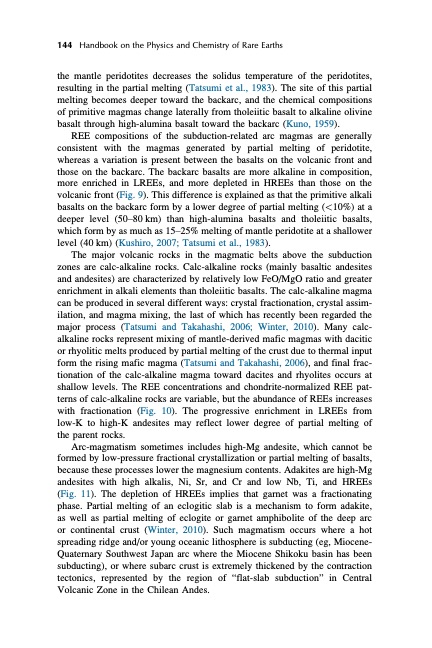
PDF Publication Title:
Text from PDF Page: 180
144 Handbook on the Physics and Chemistry of Rare Earths the mantle peridotites decreases the solidus temperature of the peridotites, resulting in the partial melting (Tatsumi et al., 1983). The site of this partial melting becomes deeper toward the backarc, and the chemical compositions of primitive magmas change laterally from tholeiitic basalt to alkaline olivine basalt through high-alumina basalt toward the backarc (Kuno, 1959). REE compositions of the subduction-related arc magmas are generally consistent with the magmas generated by partial melting of peridotite, whereas a variation is present between the basalts on the volcanic front and those on the backarc. The backarc basalts are more alkaline in composition, more enriched in LREEs, and more depleted in HREEs than those on the volcanic front (Fig. 9). This difference is explained as that the primitive alkali basalts on the backarc form by a lower degree of partial melting (<10%) at a deeper level (50–80 km) than high-alumina basalts and tholeiitic basalts, which form by as much as 15–25% melting of mantle peridotite at a shallower level (40 km) (Kushiro, 2007; Tatsumi et al., 1983). The major volcanic rocks in the magmatic belts above the subduction zones are calc-alkaline rocks. Calc-alkaline rocks (mainly basaltic andesites and andesites) are characterized by relatively low FeO/MgO ratio and greater enrichment in alkali elements than tholeiitic basalts. The calc-alkaline magma can be produced in several different ways: crystal fractionation, crystal assim- ilation, and magma mixing, the last of which has recently been regarded the major process (Tatsumi and Takahashi, 2006; Winter, 2010). Many calc- alkaline rocks represent mixing of mantle-derived mafic magmas with dacitic or rhyolitic melts produced by partial melting of the crust due to thermal input form the rising mafic magma (Tatsumi and Takahashi, 2006), and final frac- tionation of the calc-alkaline magma toward dacites and rhyolites occurs at shallow levels. The REE concentrations and chondrite-normalized REE pat- terns of calc-alkaline rocks are variable, but the abundance of REEs increases with fractionation (Fig. 10). The progressive enrichment in LREEs from low-K to high-K andesites may reflect lower degree of partial melting of the parent rocks. Arc-magmatism sometimes includes high-Mg andesite, which cannot be formed by low-pressure fractional crystallization or partial melting of basalts, because these processes lower the magnesium contents. Adakites are high-Mg andesites with high alkalis, Ni, Sr, and Cr and low Nb, Ti, and HREEs (Fig. 11). The depletion of HREEs implies that garnet was a fractionating phase. Partial melting of an eclogitic slab is a mechanism to form adakite, as well as partial melting of eclogite or garnet amphibolite of the deep arc or continental crust (Winter, 2010). Such magmatism occurs where a hot spreading ridge and/or young oceanic lithosphere is subducting (eg, Miocene- Quaternary Southwest Japan arc where the Miocene Shikoku basin has been subducting), or where subarc crust is extremely thickened by the contraction tectonics, represented by the region of “flat-slab subduction” in Central Volcanic Zone in the Chilean Andes.PDF Image | HANDBOOK ON THE PHYSICS AND CHEMISTRY OF RARE EARTHS

PDF Search Title:
HANDBOOK ON THE PHYSICS AND CHEMISTRY OF RARE EARTHSOriginal File Name Searched:
Chemistry-Rare-Earths-49.pdfDIY PDF Search: Google It | Yahoo | Bing
Sulfur Deposition on Carbon Nanofibers using Supercritical CO2 Sulfur Deposition on Carbon Nanofibers using Supercritical CO2. Gamma sulfur also known as mother of pearl sulfur and nacreous sulfur... More Info
CO2 Organic Rankine Cycle Experimenter Platform The supercritical CO2 phase change system is both a heat pump and organic rankine cycle which can be used for those purposes and as a supercritical extractor for advanced subcritical and supercritical extraction technology. Uses include producing nanoparticles, precious metal CO2 extraction, lithium battery recycling, and other applications... More Info
| CONTACT TEL: 608-238-6001 Email: greg@infinityturbine.com | RSS | AMP |